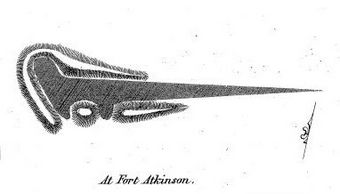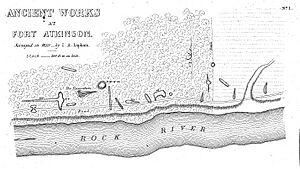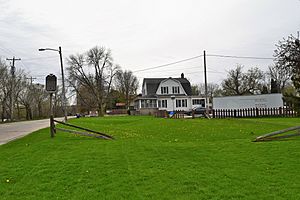Panther Intaglio Effigy Mound facts for kids
Quick facts for kids |
|
|
Panther Intaglio Effigy Mound
|
|

Lapham's sketch of the mound from 1850
|
|
| Location | 1236 Riverside Dr. Fort Atkinson, Wisconsin |
|---|---|
| NRHP reference No. | 70000035 |
| Added to NRHP | October 15, 1970 |
The Panther Intaglio Effigy Mound is a special kind of ancient artwork found in Fort Atkinson, Wisconsin. Unlike most mounds, which are piles of earth, this one is a large hole dug into the ground. It's shaped like a panther or a water spirit. Long ago, Native Americans created this unique design. In the 1800s, there were ten such 'reverse mounds' in Wisconsin, but this is the only one left today. It became a protected historical site in 1970.
Contents
What is an Intaglio Mound?
Most effigy mounds are made by piling up soil. These mounds form shapes of animals or other objects. But an intaglio is different. It's a hole dug into the ground to create a shape. Think of it like a giant cookie cutter pressing into the earth.
The Fort Atkinson Panther Intaglio
The Panther Intaglio in Fort Atkinson is a large hole. It is about 125 feet long and two feet deep. It sits on the north side of the Rock River. People have described its shape in different ways. Some say it looks like a lizard, others a panther, or even a water spirit. This shape is common among the raised mounds found in the upper Midwest.
We know this hole was made by people. It was once part of a group of more than a dozen other mounds. These included round mounds, a bird shape, a bear, and long, straight mounds. Sadly, all the other mounds are now gone. They were lost as farms and homes were built. Only the Panther Intaglio remains, preserved in a small city park.
History of the Panther Intaglio
Effigy mounds were built in Wisconsin between 700 and 1200 A.D. This means the panther effigy was dug sometime during those years. Increase A. Lapham discovered the site in 1850. He surveyed hundreds of effigy mounds in southern Wisconsin. Only eight others were intaglios like this one.
Other Intaglio Discoveries
Lapham found a 145-foot "lizard" near Forest Home Cemetery in Milwaukee. He also found four "lizard" intaglios six miles north of Milwaukee. The longest of these was 290 feet. Another 133-foot "lizard" was found near Pewaukee. There were also two smaller, shaped intaglios at Theresa.
Lapham called these shapes "lizards" because it was easy. He didn't know what they were truly meant to be. Later, archaeologists called them panthers or water spirits. Some believe many intaglio mounds were water spirits. This is because water spirits are linked to the underworld, which is like a depression in the ground.
Theories About the Intaglios
Lapham's detailed sketch shows ridges around the head and body of the animal. These were probably soil removed when the hole was dug. Stephen Peet, an expert from that time, thought the tail of the lizard or panther led to a large round mound nearby. He believed an intaglio was always connected to a round mound. He thought the round mound was used as a lookout, and the depression was a hiding place for hunters.
Only two other intaglio mounds have been found in Wisconsin. These were two bear-shaped intaglios found near Baraboo in the mid-1800s.
Saving the Last Intaglio
By 1893, all the intaglios except the one at Fort Atkinson had been destroyed. By 1910, this last remaining intaglio was also in danger. The Daughters of the American Revolution stepped in to help. They worked with ex-governor Hoard and others. Together, they managed to buy the land and save the intaglio. It is now preserved in a small park for everyone to see.



